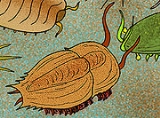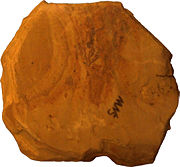
Naraoia
Encyclopedia

Cambrian
The Cambrian is the first geological period of the Paleozoic Era, lasting from Mya ; it is succeeded by the Ordovician. Its subdivisions, and indeed its base, are somewhat in flux. The period was established by Adam Sedgwick, who named it after Cambria, the Latin name for Wales, where Britain's...
strata of the Burgess Shale
Burgess Shale
The Burgess Shale Formation, located in the Canadian Rockies of British Columbia, is one of the world's most celebrated fossil fields, and the best of its kind. It is famous for the exceptional preservation of the soft parts of its fossils...
and the Maotianshan shales
Maotianshan shales
The Maotianshan Shales are a series of lower Cambrian deposits in the Chiungchussu formation, famous for their Konservat Lagerstätten, or high number of fossils preserved in place...
Lagerstätte
Lagerstätte
A Lagerstätte is a sedimentary deposit that exhibits extraordinary fossil richness or completeness.Palaeontologists distinguish two kinds....
. They were flattened, oval-shaped animals, with an uncalcified shield that was divided into two regions, a smaller region covering the head, and a larger section covering the body. There are no hint of lobes, as in true trilobites. All species were blind, showing no trace of eyes.
Naraoia fossils range between 2 and 4 centimetres in length.
The name is derived from Narao, the name of a group of small lakes in Cataract Brook canyon, above Hector on the Canadian Pacific Railway, British Columbia, Canada."
Classification
When the fossil was first discovered in CanadaCanada
Canada is a North American country consisting of ten provinces and three territories. Located in the northern part of the continent, it extends from the Atlantic Ocean in the east to the Pacific Ocean in the west, and northward into the Arctic Ocean...
's Burgess Shale
Burgess Shale
The Burgess Shale Formation, located in the Canadian Rockies of British Columbia, is one of the world's most celebrated fossil fields, and the best of its kind. It is famous for the exceptional preservation of the soft parts of its fossils...
, it was believed to be a crustacean
Crustacean
Crustaceans form a very large group of arthropods, usually treated as a subphylum, which includes such familiar animals as crabs, lobsters, crayfish, shrimp, krill and barnacles. The 50,000 described species range in size from Stygotantulus stocki at , to the Japanese spider crab with a leg span...
, such was the difference between this and other trilobites. Its continuous shield hid most of its structure, interfering with proper classification. When Harry B. Whittington
Harry B. Whittington
Harry Blackmore Whittington FRS was a British paleontologist based at the Department of Earth Sciences, Cambridge, and was affiliated to Sidney Sussex College. He attended Handsworth Grammar School in Birmingham, followed by a degree and Ph.D in geology from the University of Birmingham...
began dissecting some specimens (Naraoia was among the most populous of the Burgess Shale animals), he discovered that the legs (and gills) of the beasts were very similar, if not identical to those of trilobites, thus the current placement of Naraoia in Class
Class (biology)
In biological classification, class is* a taxonomic rank. Other well-known ranks are life, domain, kingdom, phylum, order, family, genus, and species, with class fitting between phylum and order...
Trilobita.
Related Fossil Species
Misszhouia longicaudataMisszhouia
Misszhouia longicaudata is a species of blind, trilobite-like arthropod from the Cambrian period. In 1984 a well-preserved fossil of Misszhouia was discovered in the Maotianshan Shale; this discovery brought the shale to scientific attention.M...
was initially placed with Naraoia, but was later assigned to its current genus.http://www.trilobites.info/triloclass.htm

